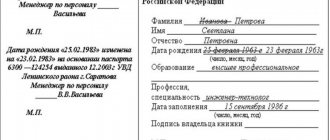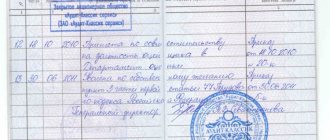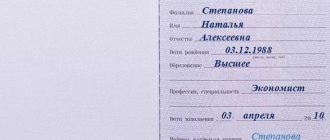General information about changes
When entering and correcting information, you cannot make a mistake in the work book. There are clear instructions for such actions, which are given in the Rules for maintaining and storing the Labor Code of 2003 (hereinafter referred to as the Rules) and in the Instructions for filling out the Labor Code of 2003 (hereinafter referred to as the Instructions).
These documents prohibit cleaning, scraping, or covering up changeable data . Strikethroughs are also unacceptable everywhere except the first (title) page of the TC. With a thin line, you can cross out for correction and change only information about the employee on the first page: full name, date of birth, education received, profession and specialty.
At the same time, it is necessary to carefully place relevant information nearby.
Neither red nor green ink, nor pencils should be used when changing entries in the TC: only ballpoint pens in blue shades or black (pens with a gel refill or nib are also not prohibited).
Abbreviating words when recording information in the TC is not allowed.
Cover page, information and education clause
When keeping records in the Labor Code, including correcting them, it is necessary to clearly understand the structure of the work book and the specifics of each of its sections. The filled space of the TC consists of three parts:
- title page (first page) with information about the owner of the shopping mall;
- pages that display information about the work;
- pages where information about awards is reflected.
You cannot mix information from these sections; this is considered a gross mistake.
On the title page for personal information about the owner in the current format TC, the following items are provided:
- for last name, first name, patronymic and date of birth - one line for each item;
- for education and profession/specialty - two lines for each item.
In the old TC forms, less space is provided for the educational column, so entries in it should be especially neat and economical.
Education in the relevant paragraph of the Labor Code according to the Instructions must be indicated exactly as it is written in the provided educational document - certificate, certificate, diploma. The document must be drawn up and certified in accordance with legal requirements.
You should not rely on oral information and enter data from the employee’s words into the educational column - this is fraught with subsequent corrections due to an incorrectly spoken or misheard word.
Redundancy of information when filling out the education column (as, indeed, any section of the Labor Code in general) is also considered an error.
The title page is not provided for entering the name of the educational document, its series and number, the name of the institution where the employee was trained, and the year of its completion.
The correctness of the data on the title page is confirmed by the employee himself with his signature. All this is certified by the seal of the organization that issued the TC form, and the signature of the employee conducting the TC.
Information about education in the work book - see sample below:
Types of education according to documents issued before September 1, 2013
The previous law on education of 1992 and the Instructions compiled according to it divided education in the Russian Federation into the following types and subtypes:
General:
- after completing nine grades - basic;
- after finishing eleventh grade - secondary.
Professional:
- after graduating from a vocational lyceum, vocational school, training center, technical school, evening school - primary;
- college or technical school: what education should be written in the work book? Write the average;
- after graduating from high school, that is, institute, university, academy - higher education;
- postgraduate (postgraduate studies, etc.).
Normative and legal documents did not provide for any dashes or hyphens in the formulation of the level of education.
The above gradation of education levels was in effect in the Russian Federation until September 2013 , and all educational documents were drawn up in accordance with it.
If the entry in the work record book about education corresponds to this classification, then experts advise indicating it, since the Instructions clearly state the need to make an entry exactly as stated in the provided document on education.
Changes in connection with the Law “On Education in the Russian Federation” No. 273-FZ dated December 29, 2012
The new law “On Education”, which came into force on September 1, 2013, made changes to the previous system, and new certificates, diplomas, certificates and labor codes filled out on their basis will have to reflect the educational level in a slightly different way.
has been moving to a new level training system for several years now , and the recently adopted law spells out changes in the samples of documents issued by educational organizations at different levels, and in the names of types of education.
Formulations of education levels such as “higher vocational” and “primary vocational”, adopted by the previous law of 1992 and enshrined in the Instructions, were abolished, and the number of subtypes of higher education increased, and they are now formulated with an indication of the corresponding level through a dash.
You can view the full text of the law here.
Making a record of education (study)
How is education documented in the work record book? In order to ensure that this important document does not have to be redone or corrections are not made, you need to be careful about entering labor records.
That is why our main task is to tell how education is entered into the work book.
So, how to make an entry in the work book about education? It should be clear and concise . It must be entered in clear and neat handwriting , in the same paste as other data from the title page. The entry should be as clear as possible, because it is possible that the employer who will hire the employee for the next position will not be able to understand the proposal.
Information about education in the work book (sample):
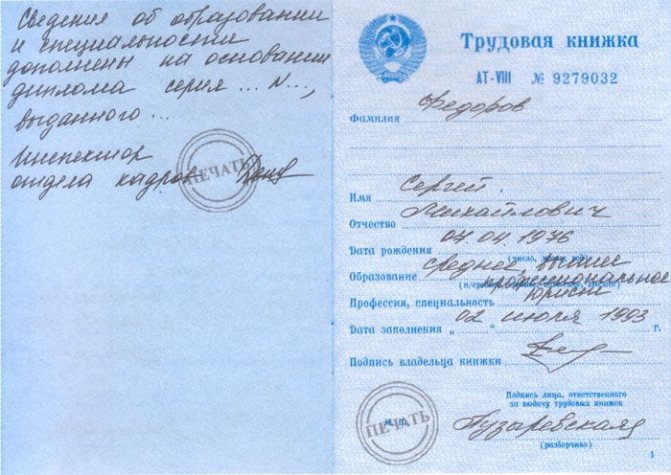
Vocational school
A vocational school is an educational institution that trains specialists for working specialties. It is not uncommon that in order to transfer to study at a higher educational institution, a vocational school graduate simply writes an application and is transferred to the second year of the institute.
Thus, we can conclude that it is impossible to call a vocational school a secondary education, because this level of knowledge is higher than that of children studying at school.
For a long time, vocational school students have been writing in their work reports that they are holders of secondary specialized education and they are absolutely right. This is the name of their specialty.
Therefore, in the work book, in the education line, we write the phrase - specialized secondary education.
How to make an entry in the work book about education after vocational school (sample):
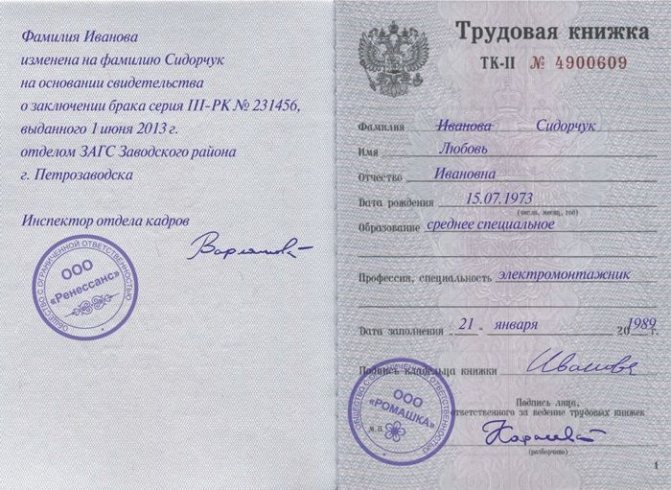
School
The school is also an educational institution where graduates of the ninth grade of schools enter.
The school pays attention to only one specific subject in order to produce ready-made workers.
Therefore, to the question “College - what kind of education is required for a work record?” one can answer that the school is also a secondary specialized education , since it is believed that graduates have a higher level of knowledge than the same schoolchildren.
Technical College
Technical schools are a dream for young people who do not want to continue studying at school, but really want to work with their hands and earn money. Technical specialties are now at a premium, which is why many people strive to get into them.
If you are concerned about the question “What education should be written in the work book if the employee graduated from a technical school?”, then you can safely indicate that he has a secondary specialized education.
It should be noted that graduates of a technical school have every right to enroll immediately in the third year of a technical higher education institution and continue their studies, becoming a specialist with a higher education in two years.
Bachelor
More recently, our country began to switch to the Bologna education system, which caused a storm of indignation among leading professors and many students.
Who are bachelors? What does a bachelor's degree entry in a work record mean?
In fact, these are specialists with an initial level of higher education . Due to misunderstanding and mistrust of people in such an education system, employers refuse to hire bachelors, and students themselves do not understand where to apply their knowledge.
Meanwhile, if you have completed a bachelor's degree at any university, you are still considered to have a higher education .
Now your main task is to find a job in your specialty.
Record of education in the work book after college (sample):
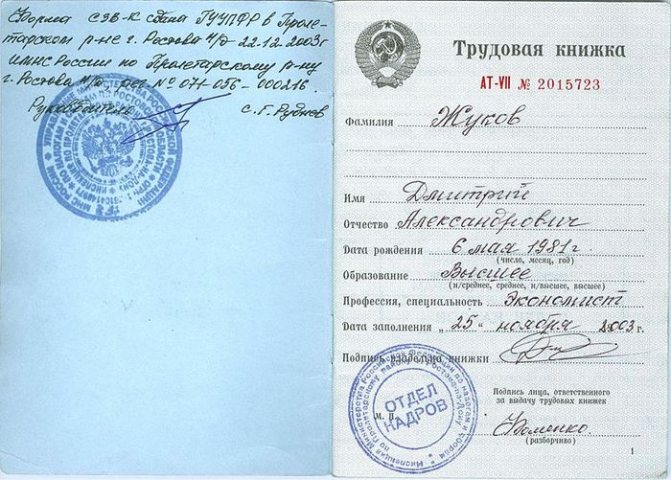
Types of education for filling out a work book according to documents issued from September 1, 2013
The gradation of educational levels now looks like this.
General education
- Nine grades of the school provide a certificate of basic general education. This formulation is included in the Labor Code if a person has no other education.
- Eleven grades of the school guarantee a certificate of secondary general education, which is recorded in the paragraph of the Labor Code on education.
Professional education
A vocational school or lyceum, college or technical school issues diplomas of secondary vocational education.
Institutes, academies, and universities provide higher education at the following levels:
- Bachelors receive a full-fledged higher education (it is considered as basic) after four years of study at a university. They are issued a diploma of higher education - bachelor's degree.
- Masters study for two years after a bachelor's degree (a narrower field of study), and receive a diploma of higher education - a master's degree.
- Specialists undergo a five- to six-year training program, which ends with the issuance of a diploma of higher education - a specialty.
- Postgraduate studies, residency, and assistantship-internships give the right to receive a diploma of higher education - training of highly qualified personnel.
Entry in the work book about bachelor's education - sample:

Incomplete and incomplete education
If a person came to an employer without yet graduating from an educational institution, then according to the Instructions, a note about this can be made at the beginning of the line about education. However, personnel officers have different opinions on this matter. “Unfinished” education means that a person continues to receive it.
If necessary, the student is issued a certificate at the university , on the basis of which you can fill out your work book with information about your incomplete higher education. But many personnel officers advise not to rush, since it is obvious that soon the person will complete the training and receive a document about it, and then the record will have to be supplemented.
The instructions do not establish a clear time period for which the education item must be filled out, so personnel officers have the opportunity to wait, leave this column empty and fill it out later, having in hand a document on full education.
The instructions also provide for the possibility of recording incomplete higher education . Until 2007, such diplomas were issued to those who studied full-time (and successfully) for two years at a university, but interrupted their studies.
The new law abolished the concept of incomplete higher education from September 1, 2013; now only information about fully completed education will be issued and recorded in the work book. However, if you have such a diploma issued before 2007, entering a mark in the Labor Code on its basis will not contradict the Instructions for filling out the Labor Code. This will help you subsequently correctly calculate your length of service, which you can read about here.
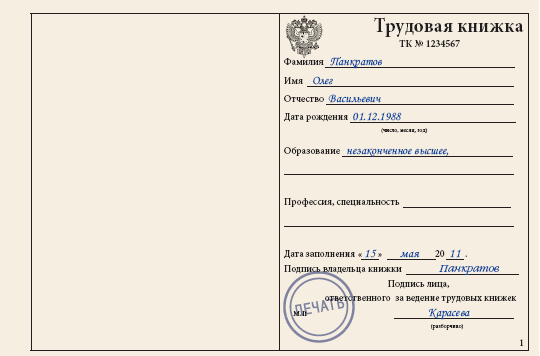
Federation of Trade Unions of Kamchatka
By virtue of clause 11, part 1, art. 81 of the Labor Code of the Russian Federation, an employment contract can be terminated by the employer in cases where the employee submits false documents to the employer when concluding an employment contract.
This rule establishes that the employer has the right to terminate the employment contract in such a situation, but this is not his obligation, i.e. the employee may continue working with the consent of the employer.
The norms of paragraphs. “b” clause 9 of the Rules for maintaining and storing work books, producing work book forms and providing them to employers (approved by Decree of the Government of the Russian Federation of April 16, 2003 N 225 “On work books”) it is determined that the following are entered into the work book when registering it information about the employee: education, profession, specialty - based on documents on education, qualifications or the presence of special knowledge (when applying for a job that requires special knowledge or special training).
The above norm indicates the need to reflect information about the employee’s education in the work book.
According to para. 3 p. 2.1 Instructions for filling out work books (approved by Resolution of the Ministry of Labor and Social Development of Russia dated October 10, 2003 N 69; hereinafter referred to as the Instructions), recording of education (basic general, secondary general, primary vocational, secondary vocational, higher vocational and postgraduate vocational) is carried out only on the basis of properly certified documents (certificate, certificate, diploma, etc.).
According to the meaning of this norm, it follows that a record of education is made on the basis of a document confirming the level of education; it is obvious that a fake diploma cannot indicate the level of education.
When information about education changes, this change is reflected in the work book in the order given in clause 2.4 of the Instructions: changes (additions) on the first page (title page) of the work book of records about new education, profession, specialty obtained are carried out by adding existing records (if they already exist) or filling in the corresponding lines without crossing out previously made entries.
According to the norms of paragraph. 2 and 3 clause 1.2 Instructions When correcting an incorrect entry, a note is made about the invalidity of the erroneously entered entry, then the correct information is entered. Obviously, in the above case, this rule should be used by analogy. Taking into account all of the above, we can make a reasonable conclusion that the employer is responsible for making corrections to the information about the employee’s education reflected in the work book. This conclusion can be drawn from the fact that a fake diploma apparently cannot indicate that the employee has received a higher professional education; accordingly, the presence of a record of higher professional education in the work book is a violation of the procedure for maintaining the work book, which is subject to correction. Otherwise, the employer is subject to administrative liability under Art. 5.27 of the Code of the Russian Federation on Administrative Offences.
The procedure for making corrections to this entry in this case is not regulated, however, it is obvious that the rule prohibiting crossing out on the first page of the work book is imperative, therefore, the correction must be made by making a note that the mark of higher education is invalid , since when adding to an existing entry, subsequent employers may have a misconception about the order in which educational entries are made, which will make it possible to consider this employee’s higher education valid. Since the legislation does not regulate the procedure for correcting an education record due to its invalidity, it is probably necessary to apply by analogy the rules that regulate the making of corrections when obtaining a new education.
How to correctly reflect information about education?
The scheme for filling out the education item is quite simple:
- They require the employee to have a certificate, diploma, certificate or a copy thereof.
- If a person has not studied beyond the primary grades of school, the education line is not filled in, since documents on preschool and primary school education are not issued.
- If a student who has not yet graduated from a university comes to work , then it is better to leave the line empty until he receives his diploma. At the request of the employee, you can make a record of incomplete higher education on the basis of a certificate from the university, and indicate “part-time” in the work book column.
- In accordance with the certificate, certificate or diploma, the “Education” item indicates the type of education received by the employee.
If the document was issued before September 1, 2013 , then first the subtype, then the type of education is entered into the education clause.
In general, the entries should look like this:
- Basic general (no hyphens or dashes);
- Average general (without hyphens and dashes);
- Initial professional (without hyphens and dashes);
- Secondary professional (without hyphens and dashes);
- Higher professional (without hyphens and dashes);
- Postgraduate professional (without hyphens and dashes).
For documents issued after September 1, 2013 , the clause in the Labor Code on education may contain the following entries:
- Basic general (no hyphens or dashes);
- Average general (without hyphens and dashes);
- Secondary professional (without hyphens and dashes);
- Higher education – bachelor’s degree (a dash is used);
- Higher education - master's degree (a dash is used);
- Higher education – specialty (a dash is used);
- Higher education – training of highly qualified personnel (a dash is used).
You can see how to fill out the title page correctly here.
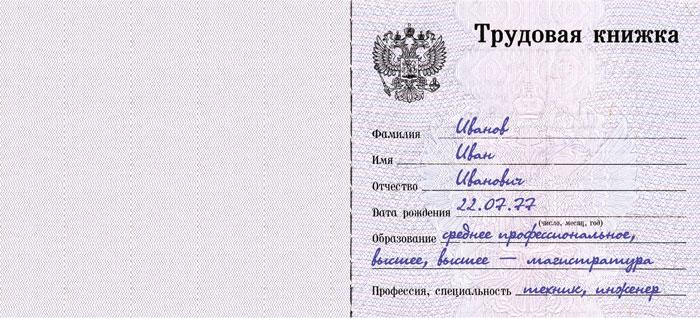
Levels of education in the Russian Federation
According to Article 10 of the Federal Law “On Education in the Russian Federation”, N273-FZ
In Russia there are the following types and levels of general education:
- preschool;
- initial general;
- basic general;
- average overall.
The following levels of vocational education are established in the Russian Federation:
- secondary vocational (vocational school, college, etc.);
- higher - bachelor's degree;
- higher education – specialty, master’s degree;
- higher – training of highly qualified personnel.
How is the clause on education in the Labor Code supplemented or adjusted?
The algorithm for changing and adding entries in the education item differs from the rules for adjusting entries in other items. Correcting your full name and date of birth requires crossing out the changed data, entering a number of correct information and mandatory indication of the documents that served as the basis for the correction.
This is logical, since new entries in the listed items cancel the old ones. But in the case of education, the next level does not cancel the previous one. If a person has increased his level of education, then do the following:
- The previous educational mark is not crossed out, but a comma is placed after it;
- Current information is simply entered after the decimal point. There is no need to refer to an educational document.
It’s another matter if the education is marked incorrectly: redundant information is entered (the type of educational document, its series and number, the name of the institution that issued it, etc. are indicated) or the entry does not correspond to the educational document.
If an incorrect entry was made when creating a new labor record, then such a labor document is considered damaged. It is better to destroy it according to the act and draw up a new Labor Code, repeating in it the records already made about work activities with this employer.
If a TC with an incorrect education record has already been transferred to another organization, then it is recommended to follow the procedure prescribed in the Instructions for correcting the information on the title page of the TC:
- An erroneous entry is crossed out with a thin single line;
- The type of education noted in the educational document is written next to it;
- The cover references the document provided by giving its title, series and number;
- The link is stamped with the employer who made the adjustment, and signed by the employee responsible for maintaining the technical documentation.
Entry in the work book about a change in education - sample:

Answer
The entry “Higher Professional” was entered incorrectly and needs to be corrected.
The method for correcting an incorrect education record is not defined by current legislation.
In our opinion, the incorrect entry (“Higher professional”) should be crossed out and the correct entry should be entered – “Higher – bachelor’s degree.” On the inside cover of the work book, details of the document on the basis of which the changes were made are indicated. Such a record is certified by the signature of the employer or a person specially authorized by him and the seal of the organization or personnel service (if there is a seal).
